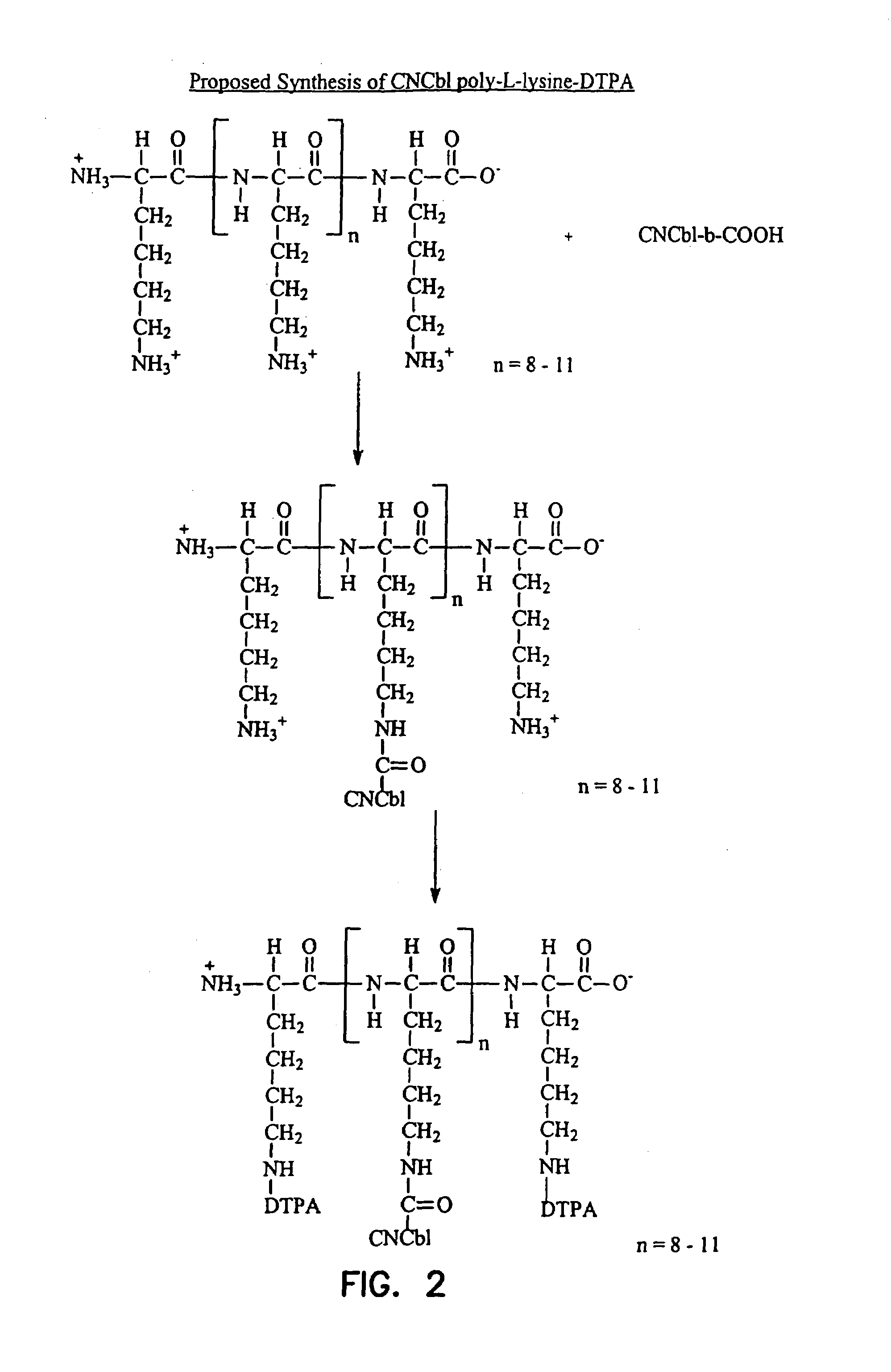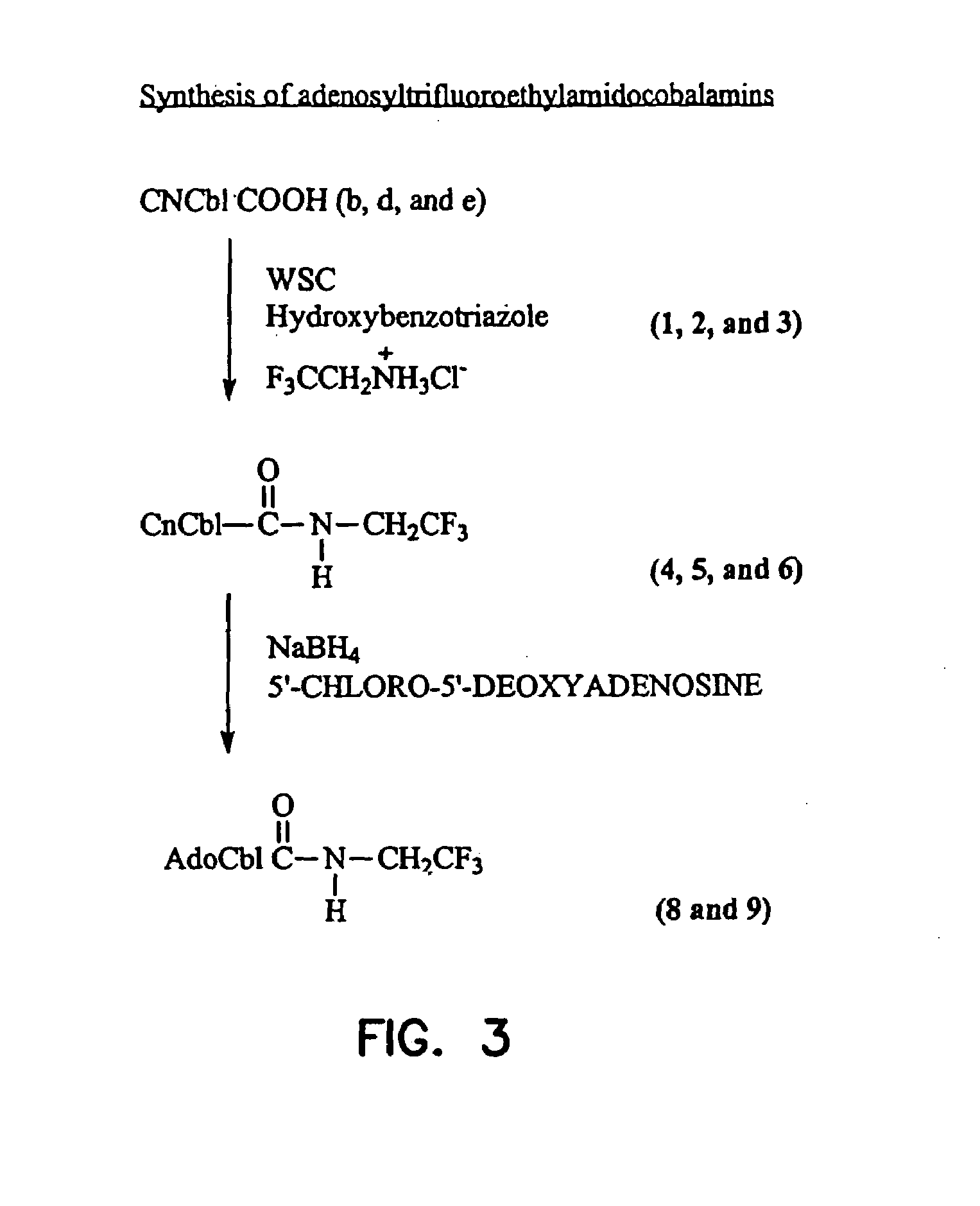Cobalamin conjugates useful as imaging and therapeutic agents
a technology of conjugates and cobalamin, applied in the direction of drugs, peptides, therapy, etc., can solve the problems of limited detection capability, and achieve the effect of low toxicity and high specificity
- Summary
- Abstract
- Description
- Claims
- Application Information
AI Technical Summary
Benefits of technology
Problems solved by technology
Method used
Image
Examples
example 1
[0100]Cyanocobalamin-Poly L-Lysine-DTPA Conjugate. Poly-L-lysine hydrobromide (Sigma no. PO879), degree of polymerization ˜11 units, molecular weight range 1000–4000 (500 mg) was dissolved in water (20 ml). Cyanocobalamin-b-monocarboxylic acid (150 mg, ˜100 μmol), 1-ethyl-3 (3′-dimethylaminopropyl) carbodiimide (480 mg, 2.5 mmol) and hydroxybenzo-triazole (338 mg, 2.5 mmol) were added. The pH of the mixture was adjusted and maintained at approximately 8 with 1 N sodium hydroxide. The progress of the reaction was monitored by thin layer chromatography on silica gel sheets using isopropanol-ammonium hydroxide-water (7:1:2) as the developing agent.
[0101]Upon completion of the reaction, the mixture was applied to a column of Sephadex G-10 (3×40 cm). The column was eluted with water and 2 ml fractions were collected. The red eluents that reacted with ninhydrin were pooled and freeze dried (i.e., lyophilized).
[0102]Recovery of the cyanocobalamin-poly-L-lysine complex (about 70%) was obtai...
example 2
[0104]Cyanocobalamin-Poly L-Lysine-DTPA Conjugate. Poly-L-lysine (Sigma no. 8954) degree of polymerization ˜8 units, molecular weight range 500–2000 (500 mg) was dissolved in water (20 ml). Cyanocobalamin-b-mondcarboxylic acid (150 mg, ˜100 μmols), 1-ethyl-3 (3′-dimethylaminopropyl) carbodiimide (480 mg, 2.5 mmol) and hydroxybenzotriazole (338 mg, 2.5 mmol) were added. The pH of the mixture was adjusted and maintained at approximately 8 with 1 N sodium hydroxide. The progress of the reaction was monitored by thin layer chromatography on silica gel sheets using isopropanol-ammonium hydroxide-water (7:1:2) as the developing agent.
[0105]Upon completion of the reaction, the mixture was applied to a column of Sephadex G-10 (3×40 cm). The column was eluted with water and 2 ml fractions were collected. The red eluents that reacted with ninhydrin were pooled and freeze dried (i.e., lyophilized).
[0106]Recovery of the cyanocobalamin-poly-L-lysine complex (about 70%) was obtained. The cyanocob...
example 3
[0108]Imaging Data. In vitro unsaturated B12 binding capacity (UBBC) has demonstrated that cyanocobalamin-poly-L-lysine, cyanocobalamin-poly-L-lysine-polyDTPA compounds have in vitro biological activity that is 92% and 43.4% when compared to cyanocobalamin. Comparison of cyanocobalamin-DTPA to cyanocobalamin was 66.4% (Transcobalamin II receptor imaging via radiolabeled diethylene-triaminepentaacetate cobalamin analogs, J. Nucl. Med., 38, 717–723 (1997); also described in U.S. Pat. No.5,739,313). The specific activity has been increased from 300 μCi in the cobalamin mono-DTPA compounds to 4.5 mCi with the cobalamin poly-L-lysine-polyDTPA complex (D A Collins, HPC Hogenkamp, M W Gebard, Tumor Imaging Indium-111-labeled DTPA-adenosylcobalamin, Mayo Clinic Proceedings, 1999; 74; 687–691; Biodistribution of Radiolabeled Adenosylcobalamin in Humans, Review of 30 patents submitted to Mayo Clinic Proceedings). This should improve tumor-to-background ratio, which can be evaluated in murine ...
PUM
| Property | Measurement | Unit |
|---|---|---|
| length | aaaaa | aaaaa |
| length | aaaaa | aaaaa |
| pH | aaaaa | aaaaa |
Abstract
Description
Claims
Application Information
 Login to View More
Login to View More - R&D
- Intellectual Property
- Life Sciences
- Materials
- Tech Scout
- Unparalleled Data Quality
- Higher Quality Content
- 60% Fewer Hallucinations
Browse by: Latest US Patents, China's latest patents, Technical Efficacy Thesaurus, Application Domain, Technology Topic, Popular Technical Reports.
© 2025 PatSnap. All rights reserved.Legal|Privacy policy|Modern Slavery Act Transparency Statement|Sitemap|About US| Contact US: help@patsnap.com



